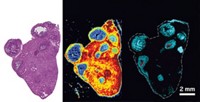Advertisement
Grab your lab coat. Let's get started
Welcome!
Welcome!
Create an account below to get 6 C&EN articles per month, receive newsletters and more - all free.
It seems this is your first time logging in online. Please enter the following information to continue.
As an ACS member you automatically get access to this site. All we need is few more details to create your reading experience.
Not you? Sign in with a different account.
Not you? Sign in with a different account.
ERROR 1
ERROR 1
ERROR 2
ERROR 2
ERROR 2
ERROR 2
ERROR 2
Password and Confirm password must match.
If you have an ACS member number, please enter it here so we can link this account to your membership. (optional)
ERROR 2
ACS values your privacy. By submitting your information, you are gaining access to C&EN and subscribing to our weekly newsletter. We use the information you provide to make your reading experience better, and we will never sell your data to third party members.
Analytical Chemistry
Profiling Tumor Cells
Cancerous and noncancerous cells can be distinguished by comparing Raman spectral lines
by Jyllian N. Kemsley
May 17, 2010
| A version of this story appeared in
Volume 88, Issue 20
Cancerous and noncancerous cells can be distinguished by comparing spectral lines from surface-enhanced Raman spectroscopy, or SERS (J. Phys. Chem. Lett. 2010, 1, 1595). The results point to a way to use spectroscopic fingerprinting to identify biomarkers on cell surfaces and improve cancer diagnosis, say Boston University’s Bo Yan and Björn M. Reinhard, who developed the technique. The approach has potential for in vivo diagnostics if techniques such as endoscopic SERS imaging are developed. Working with tumor and nontumor breast and prostate cell lines, Yan and Reinhard evaluated SERS spectra of whole cells mounted onto a nanostructured silver substrate. They were able to distinguish between the cancerous and noncancerous cells by comparing the intensity ratio of spectral bands at 722 cm–1 and 655 cm–1. The 722 band likely arises from the C–N bond in quaternary ammonium groups in components of cell membrane lipids. The 655 band is commonly observed in Raman spectra of sialic acid sugars; its intensity likely increases in cancerous cells because such cells commonly overexpress glycosylated cell-surface proteins. The researchers found that the intensity ratio of the two bands is lower in tumor cells.




Join the conversation
Contact the reporter
Submit a Letter to the Editor for publication
Engage with us on Twitter